Topic PowerPoint PPT Presentation
1 / 18
Title: Topic
1
Topic 2 Quality by Design and Pharmaceutical
Equivalence
ACPS Meeting May 2005
- Ajaz S. Hussain, Ph.D.
- Office of Pharmaceutical Science
- Center for Drug Evaluation and Research
- Food and Drug Administration
2
(No Transcript)
3
From a Reactive to a Proactive Decision
System for Pharmaceutical Quality
- Reactive (examples)
- Testing to document quality
- Repeating deviation and out of specification
investigations - Prior Approval Supplement for process
optimization and continuous improvement efforts - Multiple CMC review cycles
- Procrustean approach for demonstrating
therapeutic equivalence of generic products
- Proactive (examples)
- Quality by design and real time release
- Right First Time
- Process optimization and continuous improvement
efforts within a facilities quality system - Single CMC review cycle and risk-based
specifications - QbD approaches for demonstrating therapeutic
equivalence of generic products
This is a journey and not a destination!
4
Therapeutic Equivalence
- Drug products are considered to be therapeutic
equivalents only if they are pharmaceutical
equivalents and if they can be expected to have
the same clinical effect and safety profile when
administered to patients under the conditions
specified in the labeling.
The Orange Book
5
Pharmaceutical Equivalent
- Drug products are considered pharmaceutical
equivalents if they contain the same active
ingredient(s), are of the same dosage form, route
of administration and are identical in strength
or concentration (e.g., chlordiazepoxide
hydrochloride, 5mg capsules). - Pharmaceutically equivalent drug products are
formulated to contain the same amount of active
ingredient in the same dosage form and to meet
the same or compendial or other applicable
standards (i.e., strength, quality, purity, and
identity), but they may differ in characteristics
such as shape, scoring configuration, release
mechanisms, packaging, excipients (including
colors, flavors, preservatives), expiration time,
and, within certain limits, labeling.
The Orange Book
6
FDA classifies as Therapeutically Equivalent
those products
- Approved as safe and effective
- Pharmaceutical equivalents in that they
- contain identical amounts of the same active drug
ingredient in the same dosage form and route of
administration, and - meet compendial or other applicable standards of
strength, quality, purity, and identity - are bioequivalent in that
- they do not present a known or potential
bioequivalence problem, and they meet an
acceptable in vitro standard, or - if they do present such a known or potential
problem, they are shown to meet an appropriate
bioequivalence standard - are adequately labeled and
- are manufactured in compliance with Current Good
Manufacturing Practice regulations.
The Orange Book
7
Components of the Challenge
- Risk-based scientific decisions on pharmaceutical
quality - Risk combination of the probability of
occurrence of harm and the severity of that harm - Uncertainty with respect to severity of harm
and/or probability of its occurrence and their
modulating factors (e.g., critical quality
attributes, variability,..)
8
Confounding of Uncertainty, Variability, and Risk
- Product and process development paradigm
- Approval decision Risk/Benefit ratio
- Often intrinsic safety efficacy of an NME
confounded with its product and manufacturing
process - Multi-factorial aspect of pharmaceutical products
and manufacturing processes increasing
complexity - Establishing constraints based on prior
knowledge and limited development experiments
(time and material constraints)
9
The Pharmaceutical Quality Paradox
- A need exists first to untangle or de-convolute
uncertainty variability risk and then to
achieve a scientific (re) integration of these
for quality decisions (e.g., regulatory
application approval decisions). This may appear
to be paradoxical, and it probably is without the
concept of quality by design (QbD).
Ajaz Hussain. Process Analytical Technology A
First Step in a Journey towards the Desired
State. The Journal for Process Analytical
Technology. January 2005.
10
Risk/Benefit and Quality
11
In Vivo BE for Justifying Changes During
Development
12
Average of BE Studies At a Major
Pharmaceutical Company
13
(No Transcript)
14
(No Transcript)
15
Design is about doing things consciously
Product Performance Design specifications relia
bly and consistently deliver the
therapeutic objectives
Capability Ability to reliably
and consistently deliver the target product
design specifications
16
Points to consider..
- In the context of pre/post-approval changes,
generic drugs, and the concept of follow-on
protein pharmaceuticals, the primary goal of a
scientific decision framework should be to ensure
that an approved product is expected to have the
same clinical effect and safety profile when
administered to patients under the conditions
specified in the labeling - Furthermore identifying and elimination (or
minimizing) unnecessary human and animal testing
are also the goals of this decision framework
17
Topic 2 Premise
- A QbD approach via pharmaceutical development
information can potentially provide an excellent
means to address a number of challenges
previously discussed at ACPS meetings without
complete or satisfactory resolution for
example - bioequivalence of highly variable drugs,
bio-in-equivalence criteria, pharmaceutical and
therapeutic equivalence of locally acting drug
products (e.g., topical drug products). - In addition, further elaboration and extended
application of the Biopharmaceutics
Classifications System (BCS)-based waiver of in
vivo bioequivalence is essentially an extension
of Topic 1 discussions.
18
Our initial thoughts Are we on the right tract?
- How can pharmaceutical development information
help to extend the applications of BCS-based
waiver of in vivo studies for immediate release
products? - How can pharmaceutical development information be
utilized to address the challenge of highly
variable drugs? - Establishing therapeutic equivalence of topical
products?

